How To Remove Mold From Log Cabins? Complete Guide
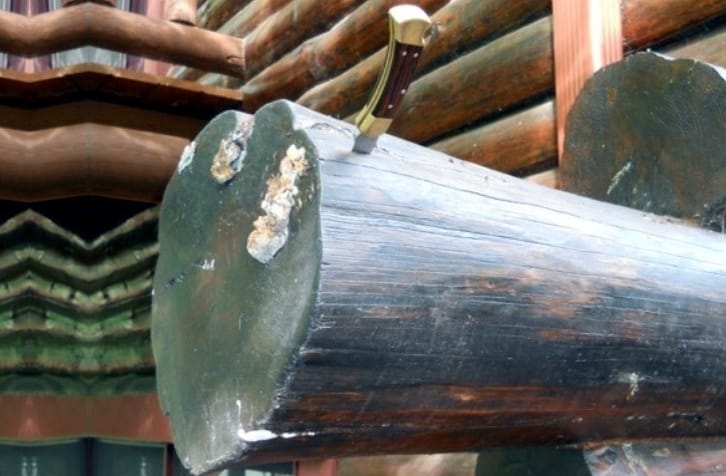
Mold on log cabins is not an unusual thing to see. If you see black spots on your logs or any kind of discoloration, it can mean that you have mold. Mold is not pretty to see and can also cause the rotting of logs. It usually appears due to constant rain or snow during winter. You should remove mold as soon as possible because it can cause damage to wood, and sometimes even mushrooms grow from it. It causes wood decay and rotting. In this article, we’ll talk about how to remove mold from the log cabins and much more. So, let’s start!
Table of Contents
How To Remove Mold From Log Cabins?
So How To Remove Mold From Log Cabins? The best way to remove mold from log cabins is to mix household bleach with four parts of water and ½ cup of biodegradable dishwasher soap. Be sure to scrub the logs generously with a mixed solution and use a stiff brush. Start cleaning from the bottom of the foundation and go to the top.
After summer rains and winter colds, it is not uncommon for mold to appear on log cabin walls. Don’t panic if you notice mold, but it is necessary to react and solve this problem as soon as possible. If you are not sure how to do it yourself, you can always hire a professional to do the job. Below we will describe why this happens and how to solve it on your own.
For those who want to learn more, be sure to read Does Log Cabin Add Value To Your Property? Expert Explain.
What To Do About Mold On Log Cabins?
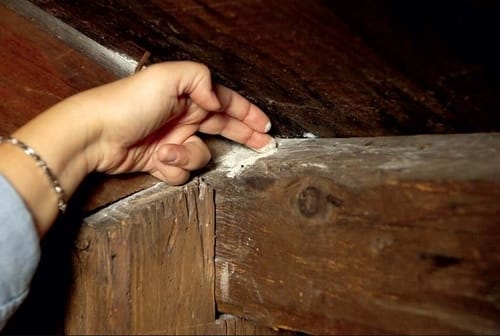
To prevent mold growth on your log cabin, ventilate and dehumidify your cabin, to keep the humidity level within limits. If your log cabin is exposed to water and moisture buildup or areas on your log cabin that comes with accessible water systems, they should be properly ventilated.
Note! Chlorine bleach can have a negative interaction with the stain, so do not use it on logs!
Make sure to cover the logs with a trap after applying something to remove the mold. When they are dried, apply a coat of stain on those logs. If the case is that the mold returns, you will probably need to replace the logs because they can be too far gone.
> Get Log Home Maintenance Guide Book Here <
How To Clean Mold Off From Outside Of a Log Cabin
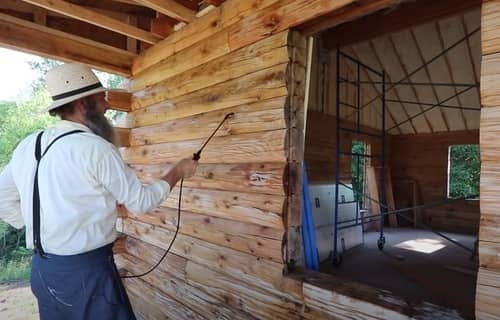
Log cabins are made of materials that are easily accessible and not complicated for maintenance. Because it is easy to work with logs, you can remove mold without a big effort and make sure that your home stays clean and looks like new. Here are a few easy steps for efficient mold removal.
- Locate mold on the logs and remove any dust or pollen from the surface with a brush or a broom.
- Put 1 part of household bleach, 4 parts of water, and ½ cup of biodegradable dishwasher soap. Try scrubbing from the bottom to the top and do that with a stiff brush and a generous amount of the solution.
- Give them a good rinse with a power washer or a hose with a pressure nozzle. Be sure to do it from the top to the bottom of the logs.
- If you have bad stains on your logs you should consider buying oxalic acid. The container that has 5 gallons of it costs around $100. Follow the manufacturer’s label directions and let the logs air dry well.
- Use a mixture of ½ cup of baking soda, 1 gallon of water, and 1 cup of vinegar to wash the painted surface. Make sure to give it a light scrub and a water rinse. You can either use a rag or a sponge to apply it. It works well around the window and door trim, steps, or porches.
- Make sure to reseal the logs with a penetrating oil-based stain and not with a non-penetrating one (varnish or polyurethane). Listen to recommendations of professionals at home and building supply stores. Some of them already have a mold inhibitor and additive products that can be mixed in to prevent mold. Always follow the manufacturer’s directions.
Here is a YouTube video that demonstrates this.
How To Clean Mold in a Log Cabin
Mold can easily ruin the charm of your log cabin and is never a good sign to have it. You can prevent it from growing by cleaning your logs often and keeping an eye on them in case of mold growth. You can clean logs on your cabin with a homemade solution of bleach, liquid dish soap, and water.
Follow this routine for cleaning a log cabin if it has mold.
- In a well-ventilated area, like the outdoors, mix a solution that is made of one part bleach and one part water with a tablespoon of liquid dish soap to a gallon of bleach. You can treat 400 square foot are with one gallon if you are dealing with moderate mold.
- Use water to spray the logs to clean them of any dirt or dust and to protect the vegetation.
- Use a hand pump to spray the solution on exterior logs or a spray bottle for the interior logs.
- If you have minor stains, skip this step. Give your logs a good scrub with the solution. Use a stiff brush and scrub it from the lower logs to the higher ones.
- Rinse the logs by using the water starting from the top. A garden hose is ideal for the exterior logs and a spray bottle/wet rag and a bucket of water for the interior ones.
- Make sure to spray vegetation that was stained by a solution.
- Use a penetrating stain on your logs to avoid a new mold appearance in the future. Do not use the superficial ones (varnish or polyurethane) because they do not seal the logs properly. Listen to the professionals and accept their recommendations.
> Get Log Home Maintenance Guide Book Here <
How to Remove Mold From Log Homes and Cabins
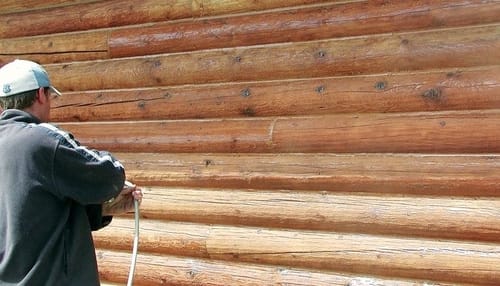
Mold also known as I Mildew can be a big enemy to your health. If you have mold in your log cabin it is important to remove it as fast as you can. Keep in mind that mold is not hard to remove, so don’t panic. Here are some of the things that you should do if you discover mold in your cabin:
1. Be Sure To Determine If It Is Mold
Not every dark or black spot on your logs is going to be mold, and it is really important to determine if the stain you want to remove is mold at all. You can check it by cutting a small proportion on it and treating it with bleach. Do not treat the whole stain because this is not a proper way to remove mold. If your small part goes away, it is probably mold.
Note! Bleach use only for testing. This is not the proper way to remove mold from logs.
Some people mistake Blue Stain for mold. This is a discoloration that can look either blue or green and black. It is caused by fungi and the only problem with it is that it does not look pretty. It does not affect logs’ integrity. There are also Tannin Stains that should not worry you. Like Blue Stains, they are also just ugly.
2. Find Out What Cause It And Fix It
If you find mold on your logs, you need to look for what is causing it. If you do not discover the problem, the mold will simply return, and the time that you spend on cleaning will be wasted.
More things can cause mold to grow. Some of them are unsealed windows, moisture or humidity, no proper ventilation in dark and wet areas, or damaged chinking and sometimes outdoor surroundings. You need to find the source of the problem first, then fix it, and after that, you can start removing mold.
3. Use Proper Protection
Mold can spike allergies in some people. Make sure to wear proper gear when treating mold. You should wear gloves, a mask, goggles, and long sleeves, and make sure to ventilate the space and wash your clothes afterward. Keep in mind that this is important for your safety.
4. Use A Log Cleaner To Wash The Logs
Remember, do not use bleach! Bleach can easily cause damage to your logs! You can use a log cleaner to wash your logs (Log Wash, Wood ReNew, etc.). Apply it on the logs in a method we discussed above and make sure to leave it on for some time to set. If you still see mold on your logs, let them dry and then repeat the whole process. It is really important to allow the logs to dry properly.
5. Prevent Mold From Happening Again
Mold can easily cause rot and a lot of damage to your cabin! You should always think two steps ahead and make sure that your log cabin is sealed properly with chinking. Your stain should be up to date and not damaged if you want to prevent mold from growing. It can do a lot of damage to your cabin. Here are some things you can do to prevent it from happening:
- Exterior
- Do not have plants and bushes too close to your log walls.
- Make sure that the sunlight can come in by trimming the trees.
- Keep the sprinklers away from your cabin.
- Prevent rain splatter and fix the gutters.
- Make sure that the chinking and stain are not damaged.
- Fill in the cracks on your logs.
- Interior
- Ventilation is the most important, especially in the bathroom and other moist places.
- Keep the humidity level low and heat your cabin.
- Stained and sealed interior.
- Use a UV protective stain and let the sunlight inside.
6. The Need For a Professional
If you have tried all the methods from above and mold is still present in your logs, you should be worried. It is better to call a professional than to leave some of it untreated. They know how to remove mold and find a problem that is causing it. If you still want to do it yourself, consult with a professional to avoid messing something up.
We have also written an interesting article that you should read: Can Log Cabins Have Basements?
FAQ: People Also Ask
Does Bleach Really Kill Mold and Mildew?
Bleach is most commonly used to kill mold and mildew on logs. It does kill it but the effectiveness as a fungicide is questionable. It is not for sure that it gets to the root of the problem and that it will not harm the wood.
Is There a Difference Between Mold And Mildew?
No, there is no difference in terms between mold and mildew. The term “mold” is more commonly used in the log home industry.
Why Does Mold Grow?
Mold usually grows when it has a source of moisture. It can also grow because of the constant exposure to nature. All in all, when you have moisture in wood or logs, you will most likely find mold, too. You cannot just remove the mold because it will grow again until your treat the source of this problem and stop the mold from ever appearing again.
Final Thoughts
Mold can be present everywhere and even in log cabins and homes. In this article, we saw how it can affect the logs themselves and what can happen if it is not completely removed. In addition to the removal itself, it is important to remove its source so that it does not return. I hope you were able to learn something new and that this article helped you.
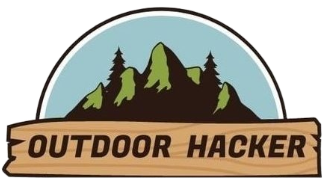

Thank you very much for sharing, I learned a lot from your article. Very cool. Thanks. nimabi
I don’t think the title of your article matches the content lol. Just kidding, mainly because I had some doubts after reading the article.